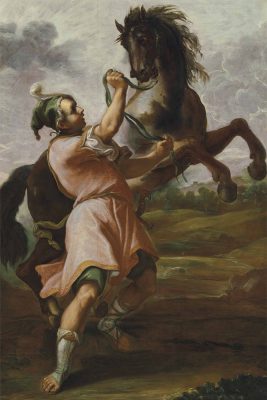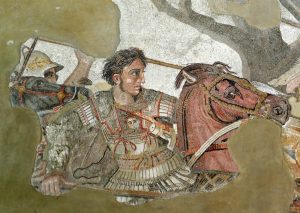Bucephalus was the horse of Alexander the Great, and the two spent ten years together. He was born around 355 B.C. and is thought by historians to be an Akhal-Teke, a Turkmen horse lineage. He was produced in the regions of Thessaly, which were well-known for breeding impressive stocks of horses. The horses in this region were usually cross-bred with Persian, Ferghana, and Scythian horses. Akhal-Teke horses are known for their intelligence, endurance, and speed and are believed to be one of the oldest living horse breeds. Bucephalus was said to have a black coat and a blue eye.
According to the Greek historian Plutarch, Bucephalus’ name comes from the Greek words “bous,” which means ox, and “kephalos,” which means head, probably because of the horse’s uncontrollable temper. The Roman author Pliny the Elder, supports Plutarch’s statement but also says that Alexander’s horse had a brand of a bull’s head on its shoulder.
Alexander first saw Bucephalus in 334 B.C. when he was twelve years old. A horse dealer tried to sell Bucephalus to Philip II for 13 talents. Philip did not even like the horse because he noticed its irritable temper. Alexander approached the horse to try and calm it down. He led it to face the sun so that it would no longer see its own shadow, which was the one thing that was scaring it. Alexander even took off his cloak that was flapping in the wind to make sure nothing else would unsettle the horse. The tactic succeeded, and young Alexander was able to control Bucephalus. According to Plutarch, Philip was so stunned at what happened that he told Alexander to search for a kingdom that was worthy of himself because Macedonia was too small for him.
Pliny the Elder also wrote about Alexander and Bucephalus’ mutual understanding, stating that Alexander was instantly enchanted at first seeing the horse that he bought it for thirteen talents. He added that once the horse was fitted with an ornamental harness, it rarely let other people mount itself, except for Alexander.
Bucephalus’s origins have a much more colorful story in the Alexander Romance, a collection of legends about the life of Alexander the Great. In these legends, which originated around the 2nd century A.D., Bucephalus was a colt whose qualities were even greater than those of Pegasus, and that Bucephalus was offered to Philip. The legend continues to narrate that the Delphic Oracle foretold that the future ruler of the world would ride Bucephalus. Bucephalus’s legend continues to expand in later versions of the Alexander Romance, where the birth and death of Alexander and his horse were held to be simultaneous. Perhaps the people behind these legends only attempted to place Alexander on the same pedestal as Julius Caesar, who had Asturcus as his horse and Caligula, his Incitatus.
The Greek historian, Arrian, says that Bucephalus died due to the injuries he suffered at the Battle of Hydaspes in 326 B.C. After this, Alexander immediately established a city in memory of his horse and named it Bucephalia. Bucephalus is believed to be buried in present-day Jalalpur Sharif, Pakistan. Pliny the Elder also wrote that when Bucephalus died, Alexander granted it funeral rites and laid it in a tomb, around which he built a city named after the horse.

